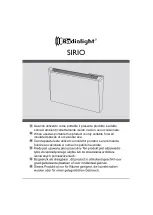
15
MIXInG valves
Water temperature over 125°F (52°C)
can cause severe burns instantly
resulting in severe injury or death.
Children, the elderly and the
physically or mentally disabled are at
highest risk for scald injury.
Feel water before bathing or
showering.
Temperature limiting devices such as
mixing valves must be installed
when required by codes and to
ensure safe temperatures at fixtures.
Water heated to a temperature which will satisfy clothes
washing, dish washing, and other sanitizing needs can
scald and cause permanent injury upon contact. Short
repeated heating cycles caused by small hot water uses can
cause temperatures at the point of use to exceed the water
heater’s temperature setting by up to 20°F (11°C).
Some people are more likely to be permanently injured by
hot water than others. These include the elderly, children,
the infirm and the physically/mentally disabled. Table 4
shows the approximate time-to-burn relationship for normal
adult skin. If anyone using hot water provided by the water
heater being installed fits into one of these groups or if
there is a local code or state law requiring a certain water
temperature at the point of use, then special precautions
must be taken.
In addition to using the lowest possible temperature setting
that satisfies the demand of the application a Mixing Valve
should be installed at the water heater (see Figure 8) or at the
hot water taps to further reduce system water temperature.
Mixing valves are available at plumbing supply stores.
Consult a Qualified Installer or Service Agency. Follow
mixing valve manufacturer’s instructions for installation of
the valves.
In all cases, the following burn table must be used. It’s
appearance may be altered to comply with each manual’s
style, but the content must remain unchanged. NOTE: If the
manual is to be used outside of the United States, metric
equivalents (Celsius) must be added to the table.
table 4
water temperature °f
time for 1st degree burn
(Less Severe Burns)
time for permanent burns
2nd & 3rd degree
(Most Severe Burns)
110
(normal shower temp.)
116
(pain threshold)
116
35 minutes
45 minutes
122
1 minute
5 minutes
131
5 seconds
25 seconds
140
2 seconds
5 seconds
149
1 second
2 seconds
154
instantaneous
1 second
(U.S. Government Memorandum, C.P.S.C., Peter L. Armstrong, Sept. 15, 1978)
dIshwashInG MachInes
All dishwashing machines meeting the National Sanitation
Foundation requirements are designed to operate with water flow
pressures between 15 and 25 pounds per square inch (103 kPa and
173 kPa). Flow pressures above 25 pounds per square inch (173
kPa), or below 15 pounds per square inch (103 kPa), will result in
improperly sanitized dishes. Where pressures are high, a water
pressure reducing or flow regulating control valve should be used
in the 180°F (82°C) line to the dishwashing machine and should be
adjusted to deliver water pressure between these limits.
HOT WATER
OUTLET
TO TANK
INLET
CHECK
VALVE
MIXING
VALVE
COLD
WATER
INLET
TEMPERED WATER
OUTLET
12” TO 15”
(30-38 cm)
CHECK
VALVE
fIGure 8.
The National Sanitation Foundation also recommends circulation of
180°F (82°C) water. The circulation should be just enough to provide
180°F (82°C) water at the point of take-off to the dishwashing machine.
Adjust flow by throttling a full port ball valve installed in the circulating
line on the outlet side of the pump. Never throttle flow on the suction
side of a pump.
Note: To comply with NSF Standard 5 installation requirements the
bottom of the water heater must be sealed to the floor with a silicone
based sealant or elevated 6 inches above the floor.
space heatInG and potable water sYsteM
Your water heater is equipped with inlet/outlet connections for use in
space heating applications (see Figure 9). If this water heater is to be
used to supply both space heating and potable (drinking) water, the
instructions listed below must be followed:
• Be sure to follow the manual(s) shipped with the air handler or other
type heating system.
• This water heater cannot be used in space heating applications
only.
• This water heater is not to be used as a replacement for an existing
boiler installation.
• Do not use with piping that has been treated with chromates, boiler
seal or other chemicals and do not add any chemicals to the water
heater piping
• If the space heating system requires water temperatures in excess
of 120°F, a mixing valve must be installed per the manufacturer’s
instructions in the potable hot water supply to limit the risk of scald
injury.
• Pumps, valves, piping and fi ttings must be compatible with potable
water.
• A properly installed flow control valve is required to prevent
thermosiphoning. Thermosiphoning is the result of a continuous flow
of water through the air handler circuit during the off cycle. Weeping
(blow off) of the temperature and pressure relief valve (T & P) or higher
than normal water temperatures are the first signs of thermosiphoning.
Summary of Contents for she100
Page 5: ...5 General safety information...
Page 56: ...56 Notes...
Page 57: ...57 Notes...
Page 58: ...58 Notes...
















































